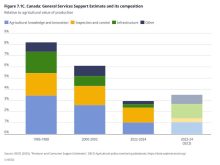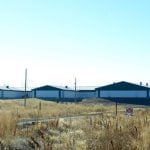After weeks of fury over federal nitrogen emission targets, the waters are muddy at best. Everyone has their own take and, as I’ve learned in my short reporting career, everyone has data to back up their view, no matter how obscure.
I can’t be the only one neck deep in position papers, scientific studies and hot takes. It’s overwhelming, and as a non-sciencey person (that’s a technical term) the idea that I’m getting it wrong despite my best efforts keeps me up at night.
So, in hopes of helping lay-folk, I asked two men of science to answer some burning questions.
Read Also

Local farm businesses, groups look forward to Manitoba Ag Days 2026
Most of agriculture is seemingly at Manitoba Ag Days each January: Manitoba agribusinesses and farm groups look forward to connecting with farmers at the 2026 show.
[PODCAST] Between the Rows: Emission deliberations
Nitrogen emissions are teeny-tiny. Why do we have to reduce them?
When we say nitrogen emissions, we mean nitrous oxide, a.k.a. N20. Fun fact: N20 is the same thing as laughing gas. It’s also nearly 300 times more powerful than carbon in terms of its greenhouse effect.
Don Flaten is a professor emeritus of soil science at the University of Manitoba.
He told me that yes, N20 emissions are small in the scheme of a farmers’ daily business. One graduate study at the University of Manitoba found that about one pound of nitrogen was lost per acre to N20 gas, or about one per cent.
Professor Mario Tenuta, who specifically studies nitrogen fertilizer and emissions, told me the percentage can be anything from two to 10 per cent.
Either way, a small loss.
[READ MORE] Grain groups call for intensity goals, not absolute emissions
An imperfect analogy might be to say N20 emissions are a tiny leak in the nitrogen fertilizer balloon. The federal government has decided it wants farmers to plug 30 per cent of that leak.
However, those emissions are responsible for more than half of agriculture emissions, Flaten said. Provincial data shows direct and indirect N20 emissions accounted for more than 50 per cent of ag emissions in 2018, measured in carbon dioxide equivalent.
Given that agriculture accounts for about a third of emissions in Manitoba, according to provincial data, this means N20 is a significant source of greenhouse gas in the province.
“Even though it’s a small agronomic loss, it has a big environmental impact,” Flaten said.
Do we know what our total N20 emissions are?
One ag leader was recently quoted in the media as saying the federal government’s data on N20 emissions came with a margin of error of plus 40 per cent and minus 35 per cent.
“It’s very fuzzy math,” the leader said.
When I looked up the number in the National Inventory Report (NIR), I found an uncertainty rate of –27 per cent to +29 per cent.
Either way, it seems like the government doesn’t really know what Canadian emissions are.
“That’s actually a fairly realistic conclusion,” Flaten said. “I don’t think anyone knows very exactly. The experts in this field know that it’s an absolute hairball to measure accurately.”
For instance, if a field varies in moisture, as is common, then the emissions across the field will vary as it gets wetter or drier.
Spatial and temporal variability “is extreme,” Flaten said. “If you can say plus or minus 30 per cent on your estimates, that’s amazingly good given the uncertainties.”
However, if looking long-term and at the typical or average emissions over many areas, times and conditions, we can still get useful information, he added. If farmers’ efforts reduce the average emissions by 30 per cent, that will be a lot better for the world as whole, said Flaten.
If everyone has scientific data, why do their opinions diverge?
Joe Schwarcz is the director of McGill University’s Office of Science and Society. He’s also a radio host and author who specializes in demystifying science for us non-sciencey folk.
He’s been dealing with scientific controversies for years.
“There is virtually no issue upon which there’s universal agreement by scientists. There is always outliers,” he said.
Sometimes opinions diverge because the study that would settle a question once and for all just can’t be done. Scientists have to make the best guess they can based on the data they have.
“Not every problem in science has a solution,” Schwarcz said. “Maybe we just don’t know.”
How very reassuring.
But Schwarcz gave some tips on how to fact-check.
First, it’s critical to ask speakers and writers what data forms the basis for their positions.
Second, some sources are more reputable than others.
With academics, ask which school they work for. Is it a reputable school with a good reputation or an obscure, no-name institution?
This goes for scientific studies too. Who did them? Who paid for them? In the nitrogen fertilizer debate, take a careful look at studies funded by a fertilizer company or by Greenpeace, Schwarcz said.
Scientists aren’t necessarily dishonest in what they publish, Schwarcz said, but if a company is paying for the research, the researcher may feel pressure to omit facts the funder might not like, “because you’ll never get another dime from that company.”
Research has shown that among studies funded by groups with vested interest, there are far more papers that benefit the funder than not, he added.
Groups like the National Research Council of Canada, which funds studies, are less likely to be biased, said Schwarcz.
Finally, look at how much attention a study received and how many other scholars have cited it in their own work. With enough digging, one can generally find where consensus lies, Schwarcz said.
Facts are hard
I asked Schwarcz if he thought people misunderstand how much certainty science can provide.
“I think so,” he said. “The only certainty is that there is no certainty. You never know every aspect of a problem.”
Again, how very reassuring.
“Nothing is as simple as it first seems,” he said. “Science is so often peppered with buts and maybes… which the pseudoscience people and the quacks are not burdened with because they know everything.”
















